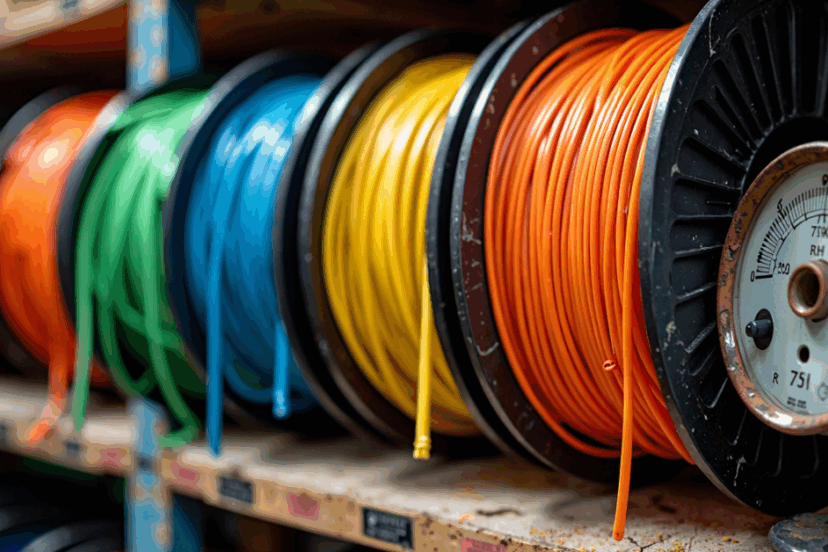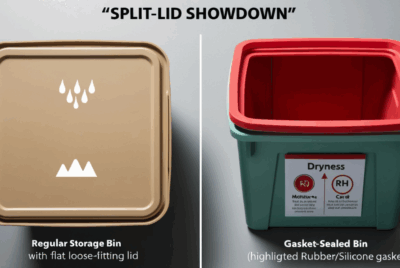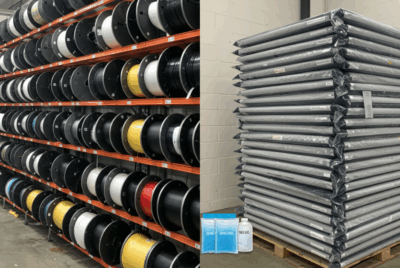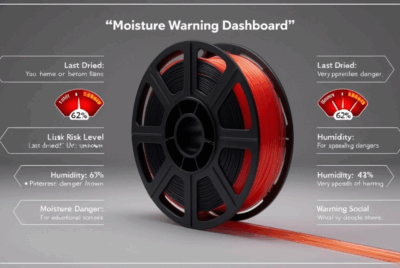Can filament be stored in a garage or basement?
1. Filament Storage Isn’t Always Convenient
We get it.
Your workspace is small. Your filament collection is growing.
And the garage or basement seems like the perfect out-of-the-way storage solution.
But here’s the question:
Can you safely store 3D filament in a garage or basement?
Let’s find out.
2. The Appeal of Garages and Basements
These areas are:
- Out of sight
- Spacious
- Already used for tools and supplies
- Not taking up your office, closet, or living room
Perfect place to stash some spools—or is it?
3. Why These Spaces Pose a Risk
Both garages and basements typically have:
- High humidity
- Wide temperature swings
- Poor insulation
- Dust, dirt, and pests
And that combo?
It’s a disaster waiting to happen for your moisture-sensitive filament.
4. Temperature Swings: The Silent Destroyer
Garages can get hot in the summer and freezing in the winter.
These extreme changes can:
- Cause condensation inside your sealed bags
- Make spools brittle from cold or soft from heat
- Reduce shelf life—even for unopened filament
Filament likes it cool, dark, and stable. Garages are anything but.
5. Humidity Levels in Garages and Basements
Basements tend to be damp year-round, even if they feel dry.
Garages often trap moisture during weather changes—especially if they’re attached.
Typical RH readings:
- Garage (average): 50–80% RH
- Basement (average): 60–90% RH
- Ideal for filament: <40% RH
You see the problem.
6. What Moisture Actually Does to Filament
When filament absorbs moisture, you get:
- Bubbling and popping when printing
- Stringing and blobs
- Weak or brittle parts
- Poor adhesion and clogged nozzles
Even if you store filament in bins, moisture sneaks in slowly if you don’t seal it tight.
7. Signs That Your Spools Are Suffering
Watch for:
- Snapping or brittle filament
- Surface that looks chalky or fogged
- Popping noises during extrusion
- Sudden drop in print quality
These are all signs your filament has been stored in a bad environment—and needs drying.
8. Can You Safely Store Filament in a Garage?
Yes, but only with protection.
DO:
- Use vacuum-sealed bags with silica gel
- Store in insulated, airtight bins
- Keep bins off the floor and away from sunlit areas
- Add a humidity sensor or hygrometer
❌ DON’T:
- Store loose spools on shelves
- Leave bags unsealed or open
- Rely on cardboard boxes or original packaging
9. Can You Safely Store Filament in a Basement?
Again, yes—with serious moisture control.
✅ DO:
- Use dehumidifiers for your storage room
- Choose plastic bins with rubber gaskets
- Rotate filament to dry it before use
- Use color-changing silica packs to monitor moisture
❌ DON’T:
- Store near exposed concrete or pipes
- Stack bins where airflow is blocked
- Assume a “cool” room = a dry one
10. Must-Have Tools for Moisture Protection
For filament stored in garages or basements, equip yourself with:
- Vacuum sealers (e.g., Geryon, FoodSaver)
- Color-indicating silica gel
- Hygrometers to monitor RH
- Stackable gasket-sealed bins
- Dehumidifier or moisture absorbers
- Dry boxes (for active-use storage)
11. Storage Containers That Actually Work in Harsh Spaces
| Container Type | Pros | Ideal For |
|---|---|---|
| IRIS Weathertight bins | Affordable & gasket-sealed | Garages/basements |
| Ammo cans with desiccant | Rugged & airtight | Long-term backup spools |
| Vacuum bags (eSun, Dry & Dry) | Compact & moisture-resistant | Individual spool storage |
| Stackable drawers (sealed) | Great for organization | Light-use basements |
Always pair with hygrometer + desiccant for max effectiveness.
12. Bonus: Using a Dehumidifier or Climate Monitor
If you’re storing a lot of filament in one room:
- Run a room dehumidifier year-round
- Use a humidity monitor like ThermoPro or Govee
- Aim for <40% RH inside bins, <60% RH in the room
Even with sealed containers, ambient humidity still matters.
13. Tips for Long-Term Storage in Non-Ideal Spaces
- Dry your filament before sealing it for storage
- Use double-bagging for extra protection
- Label with opened/dried dates
- Check stored spools every 2–3 months
- Rotate your stock to avoid forgotten, expired spools
Treat it like food storage—vacuum-sealed and monitored.
14. Alternative Storage Locations That Might Work Better
- Inside a closet or cabinet in your home office
- Under a bed in sealed storage drawers
- Inside a spare room or laundry area with controlled humidity
- Above-ground indoor storage shelves near your printer setup
If you’re limited on space, even a small dry box is better than risking it in the garage unprotected.
15. Final Thoughts: Yes—But Only If You Do It Right
You can store filament in a garage or basement.
But you must:
✅ Keep it sealed
✅ Keep it dry
✅ Check it regularly
✅ Treat it like it’s fragile—because it is
Otherwise, you’ll be drying filament and reprinting more often than you’d like.
❓FAQs
- Can I store unopened filament in the garage?
Yes—but only if it’s vacuum-sealed and stored in an airtight container away from heat and moisture. - How often should I check on filament stored in a basement?
Every 2–3 months. Monitor humidity levels and refresh desiccants as needed. - Will a dry box work in a garage?
Yes, if the box is well-sealed and kept off the ground. Consider pairing it with a dehumidifier for added protection. - Should I store filament on racks or shelves in a garage?
Only if those spools are inside sealed bins. Open racks in garages are too risky due to moisture and dust. - What’s safer—garage or basement?
It depends on your setup. Basements are riskier due to high humidity, but garages can get dangerously hot. Both require precautions.




